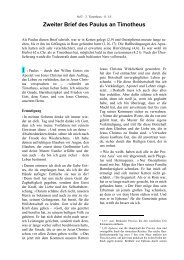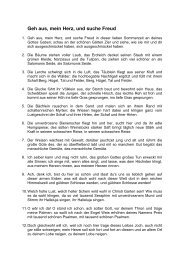You also want an ePaper? Increase the reach of your titles
YUMPU automatically turns print PDFs into web optimized ePapers that Google loves.
the inside of the eyeball. It contains the photoreceptor<br />
(light-sensitive) cells and four types of<br />
nerve cells, as well as structural cells and epithelial<br />
pigment cells (Latin: pigmentum = dye; Greek:<br />
epithel = outer layer of the skin). The two kinds<br />
of photo-cells are called rods and cones because<br />
of their shape. These microscopically small light<br />
detectors, which contain the various visual pigments,<br />
are masterpieces of technological efficiency.<br />
Each eye has about 110 million rods and 6<br />
million cones. They form a laterally interconnected<br />
network and are connected “vertically”,<br />
by means of so-called bipolar cells, to the one<br />
million ganglion cells. These collect all the optical<br />
signals received by the retina, determine the<br />
direction of flow of these signals, and transmit<br />
them to the brain through the optic nerve. This<br />
bundle of more than one million nerve fibres,<br />
each well “insulated” from the others, is about<br />
2 mm thick. Present-day communications experts<br />
using glass fibre technology can only dream of<br />
a “cable” of this kind.<br />
One single square millimetre of the retina contains<br />
approximately 400,000 optical sensors. To get<br />
some idea of such a large number, imagine a<br />
sphere, on the surface of which circles are drawn,<br />
the size of tennis balls. These circles are separated<br />
from each other by the same distance as their<br />
diameter. In order to accommodate 400,000 such<br />
circles, the sphere must have a diameter of 52<br />
metres, nearly three times as large as the hot air<br />
balloons used for advertising promotions.<br />
The photo-receptors: The rods and cones not<br />
only differ in shape, but also in function. The<br />
rods are cylindrical, while the cones are smaller<br />
and have a tapered form. In the case of low illumination<br />
as at night, the rods enable us to dis-<br />
tinguish between brightness and darkness. They<br />
are so sensitive that the absorption of a single<br />
photon results in a measurable electrical signal.<br />
This high sensitivity is achieved through having<br />
a long time lag (about 0.3 seconds) between the<br />
absorption of a photon and the emission of the<br />
electric signal, allowing a complex amplification<br />
process to take place.<br />
The cones operate much faster; their time lag is<br />
only 0.075 seconds, but they are much less sensitive<br />
than the rods, and only function optimally in<br />
daylight. There are three types of cones, distinguished<br />
by their absorption maxima, each being<br />
most sensitive for, respectively, red light (having<br />
a wave length of approximately 705 nm), green<br />
light (520 nm), and blue light (<strong>45</strong>0 nm). By comparing<br />
the messages received from the different<br />
cones, the ganglia identify the colours actually<br />
observed.<br />
We would expect the light receptors to be on the<br />
side of the retina exposed to the incident light,<br />
but, amazingly, this is not the case. The light<br />
must first pass through another layer of the retina.<br />
That is why it has been said that our eyes<br />
have “inverted wiring”, an arrangement which<br />
nevertheless works brilliantly.<br />
The light sensitive cells act like interpreters,<br />
translating the impulses of light into the language<br />
of the nervous system. Another way of<br />
putting it is that a photo-receptor cell is basically<br />
a counter which counts the number of incident<br />
light quanta (photons). Its sensitivity ranges over<br />
five powers of ten, and it is able to adapt to the<br />
brightness of the prevailing light conditions by<br />
altering its sensitivity. For example, in response<br />
to bright light, it can reduce its sensitivity<br />
100,000 times!<br />
Sensitivity: We are blessed with extremely sensitive<br />
<strong>sense</strong> <strong>organs</strong>. Furthermore, the Creator<br />
solved a universal technical problem. Whenever<br />
a radio receiver is set for maximum sensitivity, it<br />
becomes noisy. This hissing sound is caused by<br />
the irregular thermal (heat) motions of electrons<br />
in the resistors. It can be eliminated by cooling all<br />
the components to a temperature far below<br />
15
















